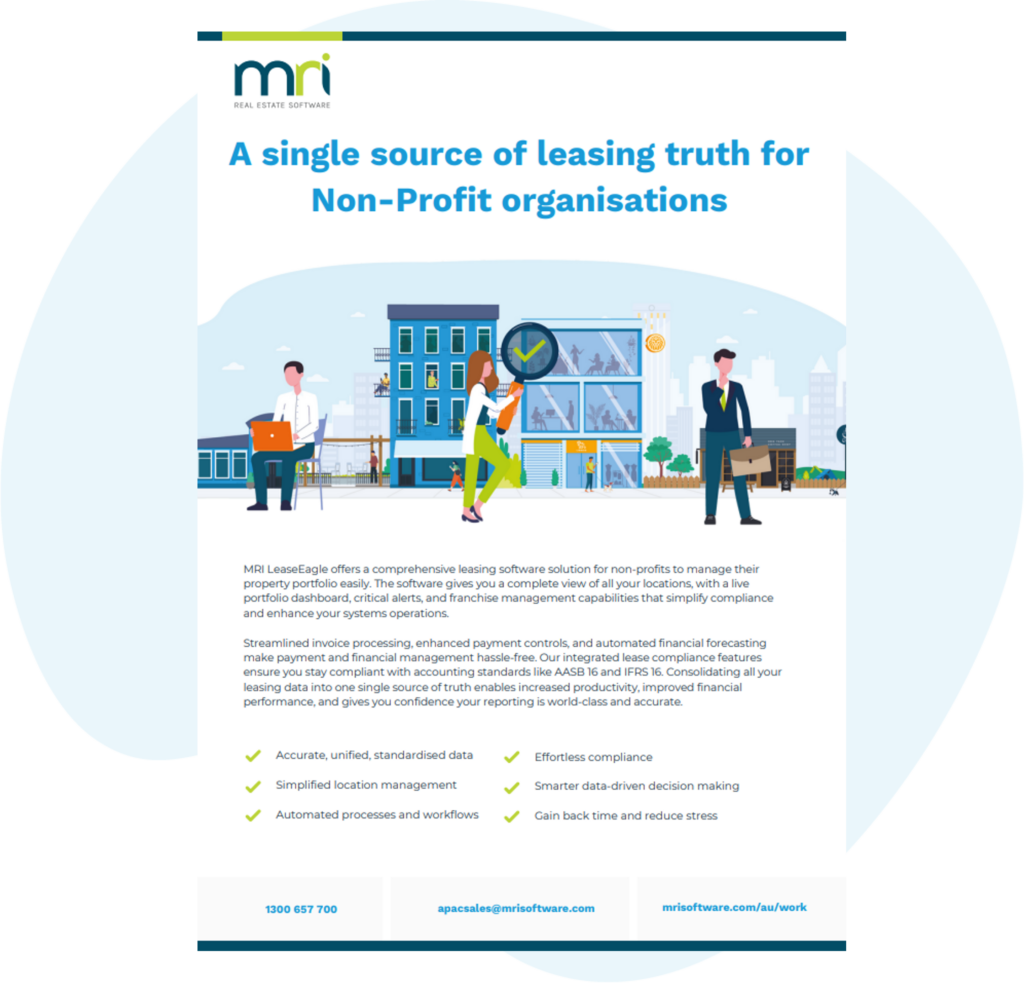Lease accounting explained
Lease accounting plays a critical role in helping you understand the financial impact of leasing arrangements. Whether your organisation is leasing property, equipment, or vehicles, your accounting team needs to keep track of how these leases affect your income statements, balance sheets, and overall financial health. With the introduction of new standards like AASB 16 and IFRS 16, there is a renewed focus on transparency, compliance, and accuracy.
If you manage leases across multiple assets, the right lease accounting software can help you stay on top of reporting requirements. These tools from MRI Software can automate calculations, reduce manual errors, and improve audit readiness. Topics like accounting for operating leases, understanding lease liabilities, or structuring a triple net lease all tie into a broader conversation about how leases are handled in financial reporting.
Contents:
- What is lease accounting?
- Types of leases
- What is an example of lease accounting?
- Why is lease accounting important?
- What is the GAAP standard for leases?
- What is the difference between old and new lease accounting standards?
- How lease accounting affects your business
- What are the benefits of the new lease standard?
- How can companies prepare for accounting lease standards?
- What to consider when evaluating lease software?
- Contact MRI Software
- FAQs
What is lease accounting?
Lease accounting refers to how you record and report the financial elements of a lease. This applies to both parties in the lease agreement, the lessor and the lessee. Your balance sheet, income statement, and cash flow statement should all reflect how the lease affects your organisation’s finances.
This process is guided by standards like AASB 16 and IFRS 16. These rules were designed to remove the ambiguity around leases that were previously left off the balance sheet. Now, most leases need to be recorded as assets and liabilities, with only a few exceptions for short-term or low-value leases.
Lease accounting aims to provide a complete picture of your organisation’s obligations and rights when it comes to leased assets. This helps you make better financial decisions and ensures that investors and regulators have a clear view of your financial position.
Types of leases
Understanding lease classification is essential for accurate reporting. Each type has its own accounting treatment, which affects how it appears on your financial statements.
1. Finance leases
A finance lease transfers nearly all risks and rewards of ownership to the lessee. You’ll need to recognise both a right-of-use asset and a lease liability on your balance sheet. Depreciation of the asset and interest on the liability are accounted for separately. This type of lease is often used for long-term agreements where the lessee intends to use the asset for most of its useful life.
2. Operating leases
Operating leases used to be recorded off the balance sheet. Under AASB 16 and IFRS 16, most operating leases must now be treated similarly to finance leases. You must recognise the leased asset and a corresponding lease liability. These leases tend to be shorter in duration and often involve assets that are not critical to long-term operations.
What is an example of lease accounting?
Suppose you lease office space for five years. Under the new standards, you must calculate the present value of all future lease payments and record this amount as a liability. You also recognise the same amount as a right-of-use asset.
Over the lease term, you reduce the liability as payments are made and depreciate the asset over time. Your income statement shows depreciation and interest expense. This gives stakeholders a more accurate view of how the lease affects your organisation’s financial health.
Why is lease accounting important?
Lease accounting helps you understand the full extent of your financial commitments. Without it, your financial statements may present an incomplete or overly optimistic picture. When leases are not recorded, liabilities are understated and your ability to manage risk can be compromised.
Transparent reporting of lease obligations allows better internal decision-making. It also supports investor confidence by giving them access to more accurate and consistent financial data. Whether you are leasing property, equipment, or vehicles, proper lease accounting makes your financial reporting more reliable.
What is the GAAP standard for leases?
Generally Accepted Accounting Principles (GAAP) include specific guidelines for lease accounting. In the United States, this is known as ASC 842. It shares many similarities with AASB 16 and IFRS 16, particularly in how it requires both operating and finance leases to be recorded on the balance sheet.
The aim is to ensure consistency in financial reporting, reduce off-balance sheet financing, and provide better insights into an organisation’s lease obligations.
ASC 842
ASC 842 is the lease accounting standard issued by the Financial Accounting Standards Board (FASB). It replaced ASC 840 and requires you to record almost all leases as liabilities with matching right-of-use assets.
Even if your business does not operate in the United States, understanding ASC 842 can be helpful. If you work with international partners, investors, or auditors, having awareness of different standards may be important for compliance and communication.
What is the difference between old and new lease accounting standards?
The biggest change is the treatment of operating leases. Previously, these were often kept off the balance sheet, which meant financial statements didn’t reflect the full scope of an organisation’s obligations.
With AASB 16, IFRS 16, and ASC 842, operating leases now require recognition of a right-of-use asset and a lease liability. This change makes your reported liabilities more complete and reduces the potential for financial misrepresentation.
Reporting is now more standardised, which improves comparability between businesses. It also makes audit processes clearer and improves stakeholder trust.
How lease accounting affects your business
Lease accounting influences several areas of your operations. It affects your financial statements, budgeting, procurement strategies, and compliance obligations. You may need to review your lease contracts to ensure they contain the information necessary for accurate reporting.
Your financial planning becomes more detailed because lease-related assets and liabilities are now part of your balance sheet. The changes may also affect debt covenants or financial ratios, so it’s important to understand the full implications.
What are the benefits of the new lease standard?
There are multiple advantages that come with adopting the new lease accounting standards:
- Greater transparency for investors and regulators
- More accurate representation of assets and liabilities
- Simplified audit trails
- Better integration with financial systems
- Improved forecasting and budgeting capabilities
These benefits make it easier for you to make informed business decisions and plan for the future.
How can companies prepare for accounting lease standards?
Start by reviewing your existing leases. Identify all lease agreements, including those previously treated as operational expenses. Develop a plan to gather the data required for calculating lease assets and liabilities.
Choose software that aligns with the standards and your internal accounting systems. Make sure your team understands the new reporting requirements and knows how to apply them in daily operations.
You can prepare by:
- Creating a centralised lease repository
- Training staff on new standards and workflows
- Establishing internal controls for lease approval and tracking
- Engaging auditors early in the process
What to consider when evaluating lease software?
Not all software is created equal. You should consider functionality, integration, user experience, and support. Look for a platform that can handle complex lease terms and automate calculations required by AASB 16 or IFRS 16.
You may also want software that includes built-in reporting features and audit tools. Integration with your existing financial systems is essential to avoid duplication or manual workarounds.
Choosing the right lease accounting software can support compliance and reduce risk while improving efficiency across your finance team.
Contact MRI Software
If you need support with lease reporting, automation, or compliance, contact MRI Software on 1300 657 700. Our tools are built to help you meet modern accounting standards with ease.
Lease Accounting Software
Comprehensive, integrated lease accounting software for every type of asset.

FAQs
A single source of leasing truth for Non-Profit organisations
MRI ProLease Express offers a comprehensive leasing software solution for non-profits to manage their property portfolio easily. The software gives you a complete view of all your locations, with a live portfolio dashboard, critical alerts, and franc…

